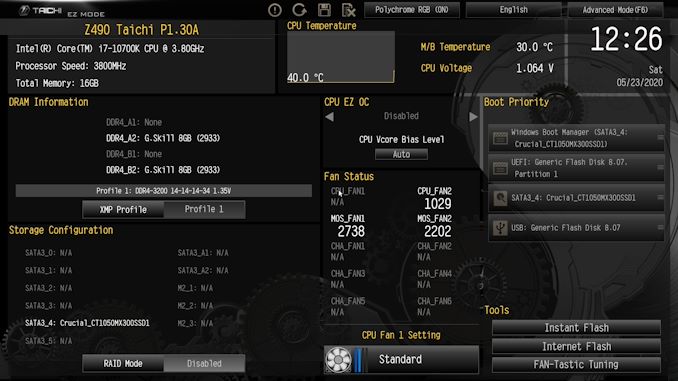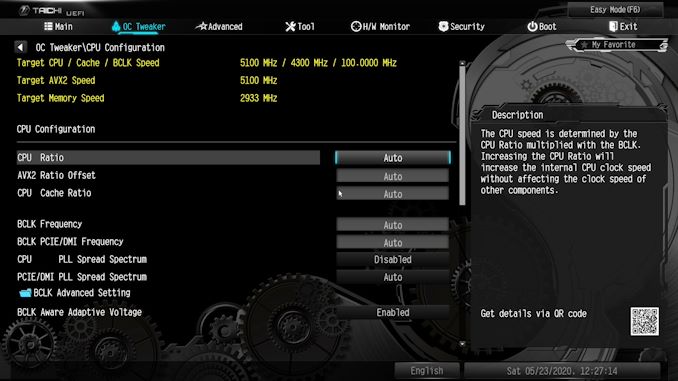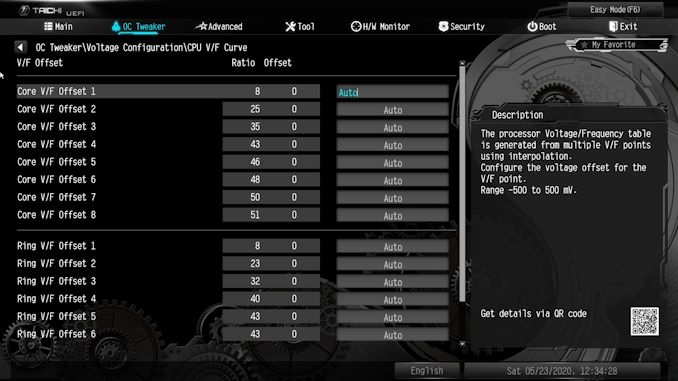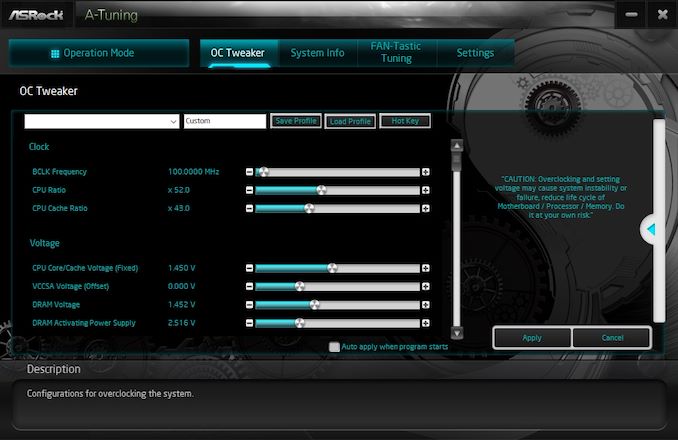The ASRock Z490 Taichi Motherboard Review: Punching LGA1200 Into Life
by Gavin Bonshor on May 27, 2020 9:00 AM ESTBIOS
The firmware on the Z490 Taichi is very similar to what we've seen previously from ASRock, including in our ASRock Z390 Taichi review. The main difference comes in the GUI with a cleaner and more aesthetically pleasing look. It includes a black background with an ASRock Taichi cogwheel inspired logo on the right-hand side. The ASRock firmware is using which text with grey highlights, including a sky blue highlight along the top menu when navigating around various areas of the BIOS.

Note we tested performance with the latest version 1.50, there were no visual differences
The ASRock Z490 Taichi firmware has two primary modes, basic and advanced. The basic screen allows users to view basic information in regards to installed hardware including the CPU, memory, storage, and cooling fans. Users can make basic customizations including enabling XMP 2.0 memory profiles or selecting one of ASRock's CPU overclocking profiles.
Along the top, there are eight different menus including the OC Tweaker, Advanced menu options and tools menu including ASRock's Polychrome RGB software which has a very user-friendly GUI. The H/W Monitor section allows users to view temperature information for a plethora of sensors within the CPU and around the board, as well as fan speed information. This section also includes ASRock's FAN-Tastic Tuning utility where users can set custom fan profiles, or allow the firmware to do the work via optimization.
Within the OC Tweaker menu, users can overclock both the CPU and memory, as well as the integrated graphics on Intel's Comet Lake desktop processors which feature it. ASRock has included a wide array of options for overclocking the CPU including core frequency control, ring frequency and for users who wish to do so, base-clock (BCLK) frequency. There is also a wide variety of memory overclocking options including frequency, latencies, and the ability to enable and disable XMP 2.0 profiles on memory kits that are supported. Further in the OC Tweaker is a dedicated section for voltage control, with a lot of voltages the regular user wouldn't need to touch. Finally, the OC Tweaker includes Intel V/F curve controls for users looking to leverage the technology for better control over turbo speeds.
Overall the firmware on the ASRock Z490 Taichi is easy to navigate and has a large collection of customizable settings for tweakers and overclockers to play with. Using the firmware which came preinstalled onto the board (1.30), it was a little laggy and unresponsive sometimes. This issue was fixed when it was flashed to the latest version at the time of testing (1.50). ASRock is good at organizing sections within the firmware with individual sections for CPU, memory, and voltage settings within the OC Tweaker menu. There is also plenty of memory latency timing customization which is good as the memory controller on Intel's Comet Lake seems to be stronger than previous generations.
Software
Supplied with the ASRock Z490 Taichi is an adequate and unassuming selection of software utilities which is spearheaded by its A-Tuning software which allows users to overclock and tweak within Windows. Also included is ASRock's Polychrome RGB software, ASRock's advertisement and gambling ridden Live Update and App Shop application, as well as a Dragon 2.5 G utility for traffic shaping.
The most prominent piece of software supplied with the ASRock Z490 Taichi is the A-Tuning utility. This allows users to overclock the CPU and base-clock within Windows, as well as make voltage adjustments in real-time. There are three preset modes, performance mode which mirrors Window's own power plan when in high-performance mode, while both standard mode and power-saving have less aggressive settings.
ASRock's software suite which is included with the accessories bundle, or via the official product page on the ASRock website, is more than enough without diluting it down. The ASRock Polychrome RGB utility allows users to turn a system into a mobile disco, while the Restart to UEFI software allows users to enter the BIOS upon the next boot, which is really handy if you're not quick enough at spamming the F2 key. The Live Update and App software offers some functionality with a handy software and driver update tool.

























57 Comments
View All Comments
Peskarik - Thursday, May 28, 2020 - link
Big thanks for the explanation, BGentry.Samus - Thursday, May 28, 2020 - link
Asus is a large OEM manufacturer and just doesn't make anything interesting anymore. That isn't a bad thing, except for innovation.Ian Cutress - Wednesday, May 27, 2020 - link
ASUS defaults to Intel recommended settings for turbo and voltage, and gives users the option to increase these in line with ASUS recommendations to get the best performance. The other manufacturers simply operate with their recommended settings out of the box, hence longer and higher turbos.Note that Intel actually encourages vendors to set their own turbo length and turbo power - what Intel provides is recommendations, but as long as the MB vendors aren't actually overclocking the frequency, they don't particularly care.
We typically test with out-of-the-box settings, to give a sense of what performance that users without any knowledge of what a turbo power limit is should expect. Given ASUS' implementation, it means they fall down on this metric, which makes it appear if the board is worse. What we should have done in this case is posted both sets of numbers and specified the difference, which is our fault. How ASUS does their options is going to be the focus of our Hero review.
rahvin - Wednesday, May 27, 2020 - link
Thanks for the comment Ian. I always do my own setting so I never noticed this, I'm glad you brought it to attention.Peskarik - Thursday, May 28, 2020 - link
Thank you, Ian! I look forward to it. For my next system I would like ASUS board + card, just to be sure all drivers etc are in line, that is why I am looking at the performance of ASUS boards in particular.Byte - Wednesday, May 27, 2020 - link
I used to only buy Asus, but i keep hearing crappy things about their ROG lines. To get similar features cost almost double in the current ROG lines vs Giga or MSI.Seems like the lower Asus lines are ok. What are you guys experiencing?
khanikun - Tuesday, June 2, 2020 - link
I got away from Asus. I stuck with them for like 10 years, but in the later years, my Asus boards kept breaking. I swapped to their WS line, which worked for a while, but then it seems they turned crappy too. They'd die in 1 to 1 1/2 years. Maybe I'm just super unlucky with Asus. I just gave up on them and moved to Gigabyte.Kind of makes me wish Abit was still around and was like their old heyday in the early 2000s. I had a good like 6-7 year run on my old IC7-Max 3 board, until the caps started leaking.
PeachNCream - Wednesday, May 27, 2020 - link
Gotta love how the word "Taichi" totally matches well with the whole brass cogs and gears theme plastered all over the plastic coverings they use to hide the PCB for - well who knows what reason. PCBs in computers must be considered ugly or something. Next stop, PCB-free, RGB-equipped windowed desktop computers!!!Deicidium369 - Wednesday, May 27, 2020 - link
When Jobs started NeXT - even the motherboard went through the aesthetic department.I support removing polychlorinated biphenyls from desktop computers - almost as insidious as RGB Disco lights. Windows are for cars, boats, airplanes, houses and not for PC cases.
I rather like the look of printed circuit boards in PCs - and the idea that you have several billion precision manufactured features in every CPU.
YB1064 - Wednesday, May 27, 2020 - link
ASRock have come a long way. I used be an ABit guy before latching on to ASUS up until Haswell. I had the opportunity to get a great deal on ASRock's Supercarrier Z270 paired with a 7700K. Superb board, tons of features, stable and overclocks quite well (5.1 GHz all cores with no effort).I must say, I miss the glory days of overclocking, i.e. tweaking the hell out of a DFI NF4 + TCCD + BH5 and employing crazy sh!% like the OCZ DDR booster.